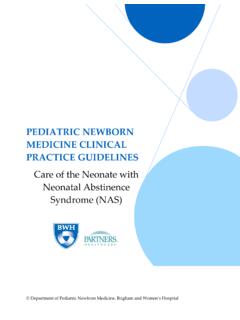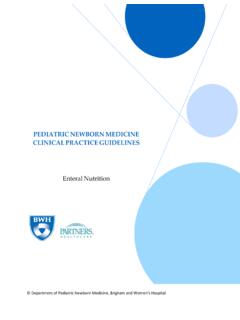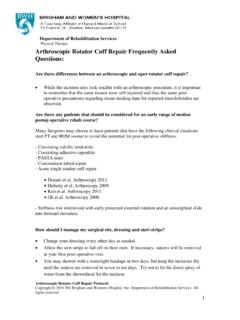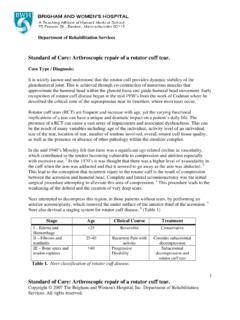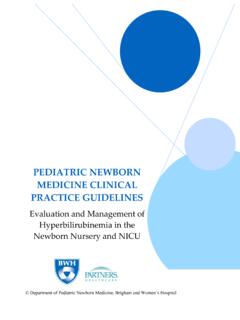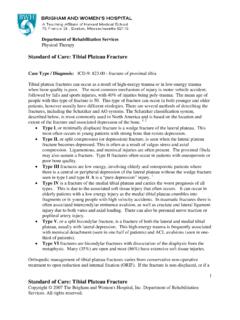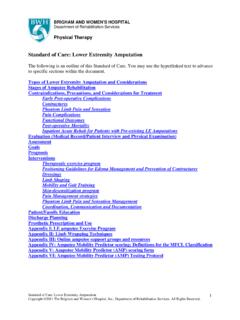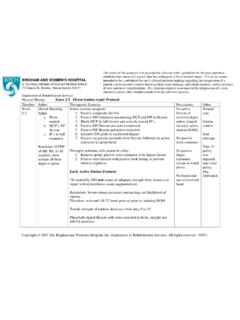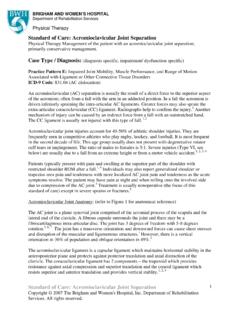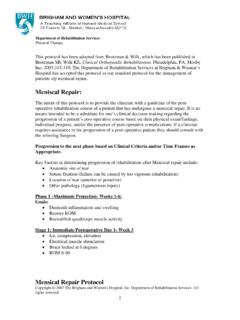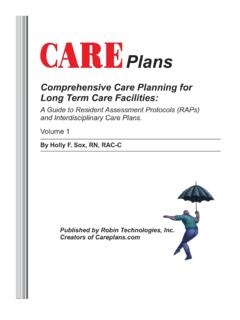Transcription of Standard of Care: Wound Care/Integumentary Management …
1 Standard of Care: Wound Care Copyright 2019 The Brigham and Women's Hospital, Inc., Department of Rehabilitation Services. All rights reserved 1 Department of Rehabilitation Services Physical Therapy Standard of Care: Wound Care/Integumentary Management Physical Therapy Management of the patient at risk for or with an integumentary disorder. Case Type / Diagnosis: This Standard of care will provide guidelines for the Management of patients who are at risk for integumentary disruption or who present with partial or full thickness wounds and would benefit from physical therapy intervention.
2 integumentary Management utilizes prevention techniques, as well as direct Wound care interventions to promote Wound healing. Wound Management is a comprehensive team approach that includes procedures used to achieve a clean Wound bed and eliminate infection, promote a moist Wound healing environment, facilitate autolytic debridement, enhance perfusion and nutrient delivery to the tissues, and protect the Wound bed during the healing process. Studies suggest that the more frequent the debridements, the better the healing outcome 1 therefore active intervention is crucial.
3 This may involve care during one or all three phases of Wound healing (inflammatory, proliferative, maturation), including the Management of resulting scar tissue . This Standard will focus on patients at increased risk for impaired skin integrity as well as the following types of integumentary disorders (with ICD-10 codes): pressure ulcer , unspecified site and stage Varicose veins of unspecified LE with ulcer at unspecified site Varicose veins of unspecified. LE w/ ulcer at unspecified site with inflammation Postthrombotic syndrome with ulcer Chronic venous hypertension (idiopathic) with ulcer Atherosclerosis of native arteries of other extremities with ulceration Nonpressure chronic ulcer of unspecified LE and severity (includes arterial ulcers) Other postprocedural complications of skin and subcutaneous tissue (includes nonhealing surgical wounds)
4 Nonpressure chronic ulcer of the skin Local infection of skin and subcutaneous tissue Vasculitis of the skin Other specified disorder of skin and subcutaneous tissue Disorder of skin and subcutaneous tissue For detailed information regarding the Management of a burn or an amputation patient, please refer to the respective Burn or the Lower Extremity Amputation Standard of Care (SOC) as neither diagnosis will be specifically covered in this document. Standard of Care: Wound Care Copyright 2019 The Brigham and Women's Hospital, Inc.
5 , Department of Rehabilitation Services. All rights reserved 2 Indications for Treatment: The specific practice pattern identified in this SOC is the complete integumentary Practice This encompasses the primary prevention and risk reduction for integumentary disorders and impaired integumentary integrity associated with superficial, partial-thickness, and full-thickness skin involvement. The APTA s Section on Clinical Electrophysiology and Wound Management and Guide for integumentary / Wound Management Content in Professional Physical Therapist Education3 is an excellent and comprehensive resource that will certainly help both the novice and more experienced clinician cultivate his/her skills during this process.
6 This document from the APTA provides an outline of the necessary contextual background to assist with fully understanding tissue healing and expected outcomes as well as determining and performing appropriate tests and measures, suitable interventions, and complete assessments for this patient population. Contraindications / Precautions for Treatment: Depending on the etiology of the integumentary disorder, the specific contraindications and precautions may vary. Please refer to the specific orders in the computer/patient chart or discuss with the appropriate/consulting service ( Plastic Surgery, Vascular Surgery) if questions arise regarding the details of an individual patient s care.
7 For patients with an elevated International Normalized Ratio (INR) of greater than or equal to , please consult the physician or nurse practitioner prior to initiating The following precautions and/or contraindications have been identified and discussed with the BWH medical staff and stand as the general precautions for the below noted patient situations. These guidelines should be maintained unless otherwise stated in the physician orders. For split thickness skin graft (STSG) or full thickness skin grafts (FTSG) that involve the lower extremity, a patient will remain on bedrest for 3-5 days.
8 To prevent shearing or injury to the new graft, no range of motion of the affected limb is allowed until notified by a physician or nurse practitioner. The above information is applicable whether or not a graft crosses a joint. It is likely that a graft that does cross a joint will warrant further immobilization of the involved joint ( with a knee immobilizer or resting foot splint) to prevent any ROM. Specific weight bearing precautions should be identified with the primary team prior to mobilization. Depending on the site of the graft or the Wound , the patient may be non-weight bearing, partial weight bearing, heel weight bearing, forefoot weight bearing, or even weight bearing as tolerated.
9 For donor sites, there are no activity, ROM or weight bearing restrictions, although some pain can limit tolerance for activity. Generally, the donor sites will be dressed with Xeroform ; the dressing remains in place until it falls off or is taken off by a physician. Occasionally VACS are used for larger donor sites Standard of Care: Wound Care Copyright 2019 The Brigham and Women's Hospital, Inc., Department of Rehabilitation Services. All rights reserved 3 Vacuum assisted closure (VAC) therapy can be used over grafts and directly on wounds to promote healing.
10 If over a graft, the same precautions as listed above are applicable unless otherwise specified by the surgical team. Check with a physician prior to initiating mobility and/or ROM as well as for specific weight bearing precautions (if any). If the VAC is used over a Wound , then there should not be any additional activity precautions except for the identified weight bearing precautions. It is critical to ensure that the VAC remains on suction during mobility. Please note: At this time, the current VAC system used at BWH automatically transitions to battery power when unplugged from the outlet.
